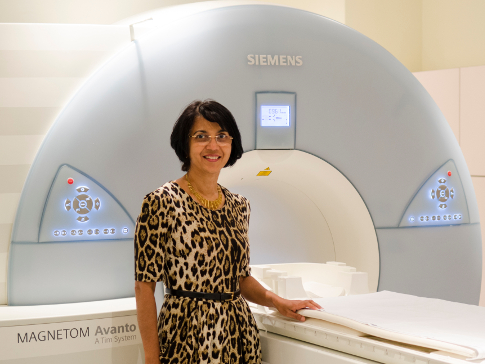Radionuclide therapy doesn’t have the profile of other types of treatment, but it is quietly making some important strides in the fight against cancer. It is a form of targeted therapy in which radioisotopes are tagged onto tumour-seeking vehicles - and it can not only seek out specific primary tumours, but can also hunt down elusive metastatic sites.
Wanting to find out more, I managed to catch a session at the NCRI conference on molecular imaging and nucleotide therapy, chaired by our own Professor Nandita deSouza.
It soon became clear after the opening session from Professor Katherine Wells from the Oxford Institute for Radiation Oncology that there are some barriers hampering progress of individualising radionuclide treatment plans.
Most radiopharmaceutical treatments involve the administration of fixed levels of radioactivity. But the effect of treatment is dependent on how much of the dose is absorbed, which can vary between patients and depends on the type of radionuclide used. Professor Wells has been working with Dr Glenn Flux at The Institute of Cancer Research and The Royal Marsden, who has developed a software package called qDose that uses image-based dosimetry to calculate absorbed dose distributions. Once fully developed, it should be suitable for clinical trial use, optimising response and minimising side-effects for individual patients.
Dr Joel O’Sullivan from Queen’s University Belfast and Northern Ireland Cancer Centre finished the session with an enthusiastic talk on Radium-223, a radionuclide that has been recently licensed for the treatment of advanced prostate cancer.
Bone-seeking radionuclides have been around for nearly 30 years, and have shown clear benefits for the relief of bone pain in men whose prostate cancer has spread to the bone, but they have never been shown to have a survival benefit. Radium-223, however, has changed the landscape of radionuclide treatments.
In 2013, Dr Chris Parker from The Royal Marsden and the ICR carried out the key registration trial –ALSYMPCA – which led to Radium-223’s approval. In this trial, Radium-223 improved survival by 3.6 months compared with placebo – an amazing result for men who on average only had a predicted survival of 12 months.
So what does the future hold? Personalised treatment planning using dosimetry looks to become a reality for radionuclides, helping to individualise treatment. Radium 223 is one of the most promising agents so far, and there is talk of combining it with other treatments such as docetaxel. It’s certainly an exciting area of research at the ICR, so watch this space!
